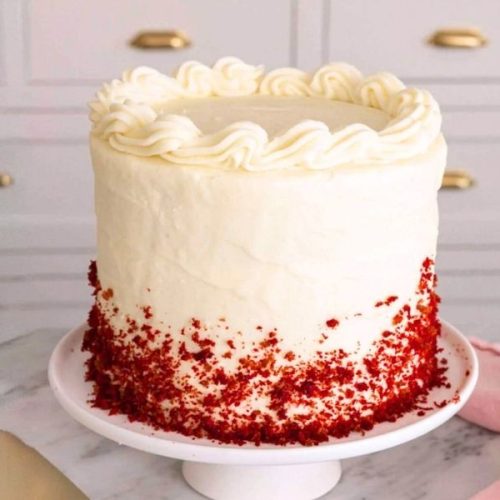
Rich and Creamy Red Velvet Layer Cake
A moist, tender Red Velvet Cake layered with creamy, tangy cream cheese frosting—perfect for celebrations or anytime indulgence. Easy-to-follow steps make this classic dessert accessible to all skill levels.
Equipment
- 3 × 6 inch cake pans
- Mixing Bowls
- Electric hand or stand mixer with paddle attachment
- Wire cooling rack
- Piping bag and decorative tip
- Sifter
Ingredients
For the Cake:
- 2 ½ cups 300g all-purpose flour
- 1 teaspoon salt
- 1 teaspoon baking soda
- ½ cup 113g unsalted butter, softened
- 1 ½ cups 300g granulated sugar
- 2 large eggs at room temperature
- 2 teaspoons pure vanilla extract
- 2 tablespoons unsweetened cocoa powder
- 1 cup 240ml buttermilk, room temperature
- 1 tablespoon white vinegar
- 1 to 2 tablespoons liquid red food coloring
For the Cream Cheese Frosting:
- 2 packages 8 ounces each, 454g total cream cheese, softened
- 1 ½ cups 340g unsalted butter, softened
- 1 teaspoon vanilla extract
- Pinch of kosher salt
- 5 ½ cups 675g powdered sugar, sifted
Instructions
- Prepare the Cake Pans: Preheat your oven to 350°F (175°C). Lightly grease three 6-inch round cake pans and dust them with flour, tapping out any excess. Alternatively, if using 9-inch pans, grease and flour two pans accordingly.
- Mix Dry Ingredients: In a medium bowl, whisk together the all-purpose flour, salt, and baking soda to combine evenly. Set aside.
- Cream Butter and Sugar: In a large bowl or the bowl of a stand mixer fitted with the paddle attachment, beat the softened butter on medium speed until creamy. Gradually add the granulated sugar and continue beating for about 3 minutes, until the mixture is light and fluffy.
- Incorporate Eggs and Vanilla: Add the eggs one at a time, beating well after each addition to ensure full incorporation. Then mix in the vanilla extract until combined.
- Add Cocoa Powder: Sift the cocoa powder directly into the butter mixture and mix just until it’s incorporated, scraping down the sides of the bowl to keep the batter uniform.
- Combine Buttermilk Mixture: In a measuring cup, stir together the buttermilk, white vinegar, and red food coloring. Adjust the amount of food coloring based on the desired intensity of red.
- Alternate Adding Dry and Wet Ingredients: Reduce the mixer speed to low. Add half of the flour mixture to the batter, followed by half of the buttermilk mixture. Mix just until combined, then repeat with the remaining flour and buttermilk. Be careful not to overmix to keep the cake tender.
- Distribute Batter and Bake: Divide the batter evenly among the prepared pans. Bake for approximately 30 to 35 minutes, or until a toothpick inserted in the center comes out clean and the cakes spring back when gently pressed.
- Cool the Cakes: Allow the cakes to cool in the pans for 10 minutes. Then carefully invert them onto wire racks and let cool completely before frosting.
- Prepare the Cream Cheese Frosting: In a clean mixing bowl, beat the softened cream cheese and butter together on medium speed until smooth and fluffy, about 3 minutes. Add vanilla extract and salt, mixing until combined.
- Add Powdered Sugar: Gradually sift the powdered sugar into the cream cheese mixture while beating on low speed. Once all sugar is added, increase speed to medium and whip until light and fluffy, about 1 minute.
- Assemble the Cake: Place one cake layer on your serving plate. Spread approximately ½ cup of frosting evenly over the top. Repeat with the second layer and frosting. Top with the final cake layer and cover the entire cake with the remaining frosting.
- Final Touches and Chill: Smooth the frosting using an offset spatula or bench scraper. Decorate with piped frosting if desired. Refrigerate the cake for at least 1 hour to set the frosting before serving.
Notes
- To achieve perfectly flat cake layers, trim any domed tops with a serrated knife or use cake strips during baking to encourage even rising.
- For the most precise flour measurement, use a kitchen scale. If unavailable, lightly spoon flour into measuring cups and level with a knife—avoid packing.
- Bringing ingredients like eggs, butter, and cream cheese to room temperature ensures smoother mixing and prevents overworking the batter.
- Avoid microwaving butter to soften it; instead, cube it and let it sit at room temperature for 1-2 hours.
- If buttermilk isn’t available, mix 1 cup of milk with 1 tablespoon of white vinegar or lemon juice, let sit for 5 minutes, then use as a substitute.
- Store leftover cake in an airtight container at room temperature for up to 2 days, or refrigerate for up to a week for freshness.